|
Monday, March 7, 2011
Progress Notes
A few weeks ago I received the following letter from one of our outstate readers, Kathleen Walker of Tulsa, Oklahoma:
President Joe,
I am interested in the photo of a forge you had on the Progress Notes of September 22, 2008 which I saw on your website (photo 01a).
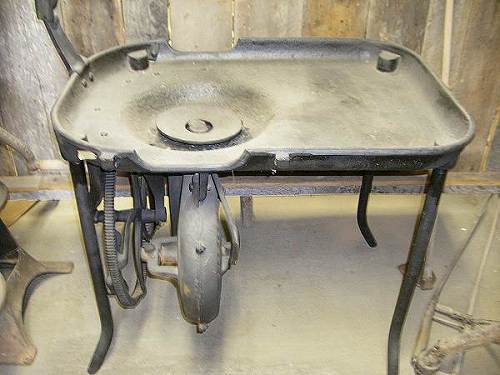
01a Old Blacksmith Forge
Note: Here is the website to which Kathleen refers.
My fiancé has recently been gifted with a forge that looks a great deal like the one in the photo. I’m wondering if you know anything about it. Our forge has an interesting air pumping feature that is centrifugally powered. I’m not a blacksmith and know little about this, but my fiancé is looking for a photo of such an apparatus so that he could reproduce it in order to get the forge working. The forge you display is square/rectangular and has a pump-jack type wooden handle attached that powers the air/billows. We are needing photos of the mechanism to see how it works. I think he thinks he can reproduce any missing parts in his other forge. We are wanting to stay as primitive, true to the original, as possible. Are you a blacksmith?
|
I answered Kathleen’s letter writing first of all that “No, I’m not a blacksmith, that’s for sure.” But I did examine the old forge and decided that it was somewhat rusted which would mean it would be difficult to disassemble; however, I invited Kathleen and her husband to come to the museum where we together could specifically help him get a closer look at the parts he needed to help him with his project back home. However, the interest in the old forge reminded me that a century or more ago the blacksmith was one of those in the community who had the skills most wanted except perhaps for the local doctor. Every Miller County community then had a blacksmith who also was the farrier as well. And the skills of blacksmithing and of a farrier were so necessary on the farm that many of the local farmers could do some of that type of work themselves.
Judge Clyde Lee Jenkins (photo 01b), author of Volumes I and II of the book, Judge Jenkins’ History of Miller County VI and VII, understood well the importance of the blacksmith in the early history of Miller County. Here is what he wrote in Volume II:
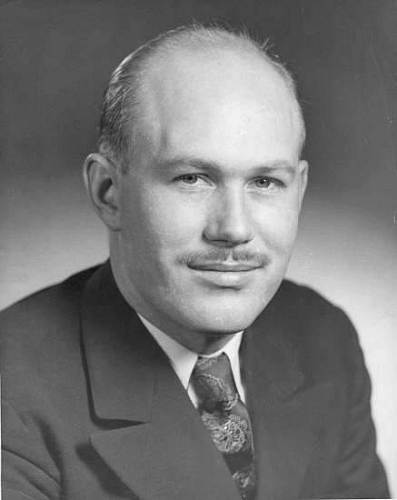
01b Clyde Lee Jenkins
Blacksmiths
Clyde Lee Jenkins
Judge Jenkins History of Miller County V2, p. 65
Although the millers, distillers, and carders were a society by themselves, for in the eyes of the people they were skilled artisans, the workmen most highly regarded in this era were the blacksmiths. A good blacksmith, in the minds of the inhabitants, was a man of great dignity. He was the maker, the builder, the handler of iron without which the farmer could not turn or till the soil, keep their horses shod, or the wheels turning on their conveyances moving farm produce to market along the rough trails.
The ringing of anvils, the coughing of billows, the blazing of forges, with the sparks flying and spitting as the blacksmith, with his big hammer, expertly shaped a piece of white hot iron, were sights little children could never forget.
Every male child wanted, when grown up, to be like the dirty, sweating man making the anvils ring… “The Village Blacksmith.”
The poetic manner in which Clyde Lee describes the old time blacksmith (who almost always was a farrier as well though few may have used that word) is a tribute to the romantic and respectful attitude accorded the blacksmith by the citizens of his community. Most blacksmiths could work and shape metal for just about any task. However, most of their work probably was for shoeing horses, a task which required the skills of a farrier as well as blacksmith. This idyllic feeling for the old time blacksmith and farrier is revealed in quite a lot of artists’ depictions of blacksmiths at work in their shops. It seems that many artists envisioned a romantic aura surrounding the blacksmith/farrier and quite a few paintings featuring blacksmiths through the years have been collected and displayed.
I did a survey of our website and found that blacksmith was number nine in order of occupations named; however, again, many farmers did their own work so the real number of those who were blacksmiths and farriers would probably be more than officially recognized (photo 13).
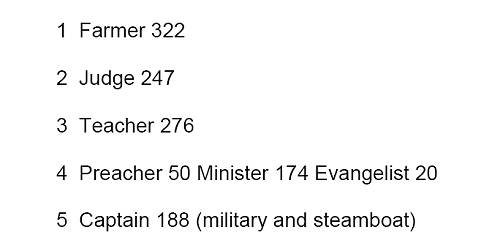
13 Occupations in Order
Click image above to read entire document in PDF format
Perusing our website I discovered that often times the biographies indicated who at one time or another were blacksmiths. Here are a few of their photographs although many blacksmiths mentioned did not have a photo available (photos 14 - 26).
Hover your mouse pointer over the images below to view the captions and click on any of the photo thumbnails to view a larger image.
Note: Once you click on an image below, a new window will open. It would be best to maximize this new window by clicking on the middle box in the upper right-hand corner of the window. When you move your cursor over the image in this new window, it will change to a magnifying glass. Once this occurs, click on the image and it will show in a larger format for easier viewing.
Here are some photos of blacksmith shops or locations that we have in our files (photos 27 - 32):
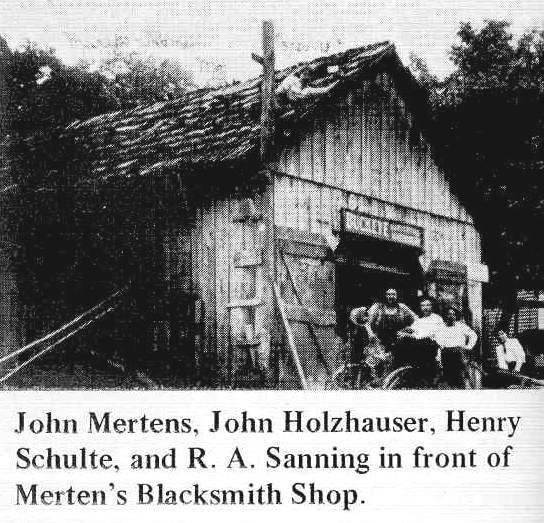
27 John Mertens Blacksmith Shop
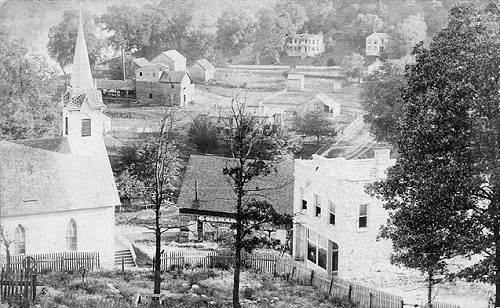
28 John Weitz Shop - Left of Bank
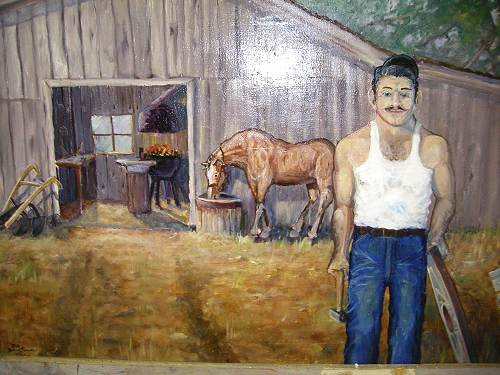
29 Tom Baughman and his Blacksmith Shop
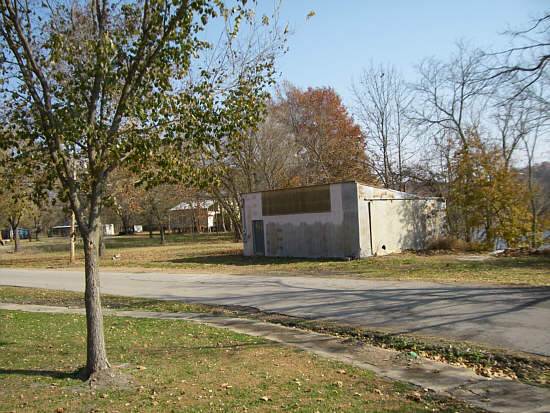
30 Approximate position of John Kallenbach and Elmer Flaugher Blacksmith Shop in Tuscumbia
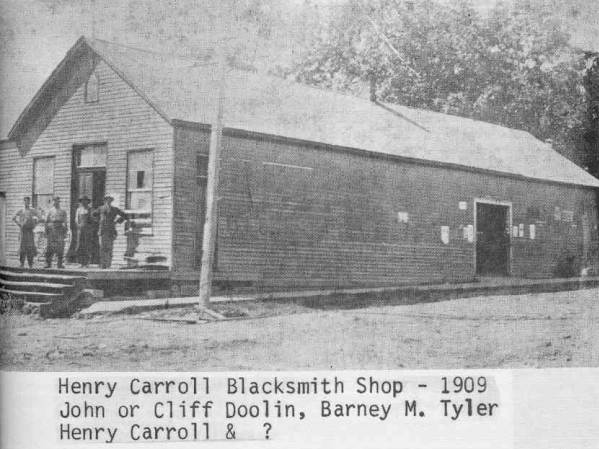
31 Henry Carroll Blacksmith Shop
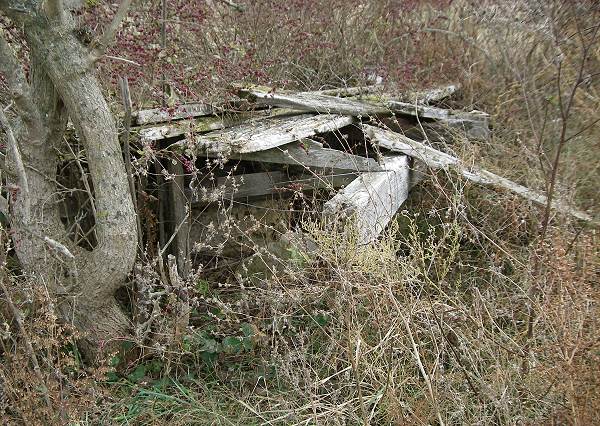
32 Abel Jarrett's Farm Blacksmith building now Collapsed
The blacksmiths in Tuscumbia where I was raised were John Weitz and John Kallenbach early on. (I don’t have a photo of John Weitz; however, John Kallenbach’s photo is listed above in photo 20). According to Louie Lawson, Tuscumbia historian, John Weitz’s blacksmith shop for many years was located across the street on the lower side of the Bank of Tuscumbia (see photo 28). I remember when I was a boy that some run down buildings were at that location, probably the last vestiges of John’s blacksmith shop. I was also told that Billie Burris had a livery stable there as well.
On the other side of town, John Kallenbach had a blacksmith shop just across the street from the old Woodman Fellow Hall building. That shop no longer is present and is replaced now by a more modern small shed (see photo 30). The blacksmith I do remember during my youth, Elmer Flaugher, used that building for blacksmithing for several years (see photo 16). Later, he did blacksmith and farrier work at a shed behind his home over on the other side of town on Possum Trot Street. John Klug, I have been told, also did some blacksmith work; however, when I knew him he ran a livestock truck between Tuscumbia and St. Louis (see photo 21).
I had a saddle horse from about the age of ten which I used a on the farm mostly to ride the fence line to find where the cows were getting out (and where Jim Harrison's bull was getting in). Elmer Flaugher was still blacksmithing then as well as serving as the local farrier. He always sent me to Hauenstein's store to get the shoes for my horse when it needed shoeing (photo 33).
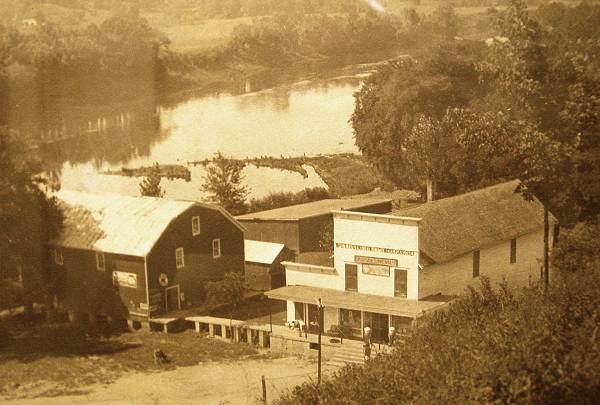
33 Hauenstein's Store
I remember the bins of shoes and square horse shoe nails stored in the west section of the store where farm tools and equipment could be found as well as a lot of horse tack. Elmer usually didn't need me to buy any "toes" for the shoes; however, by the time I came along times had changed and some of the roads had been paved in town causing my horse to slip and slide as I was riding it to the saddle club arena in the ball park. So I remember one time he had me get some toes from the store which he forged at the front of the shoe and he heated the shoe horns at the rear to bend up some "caulks," all to give the hooves some traction on the pavement. Elmer was a man of many talents. Besides being the town blacksmith for many years he also was well known for the "Jon Boats" he constructed. In addition he had been a "tie whacker" and continued making fiddles all his life (see photo 16).
In Eldon, a well known blacksmith was Tom Baughman. Tom was born in 1908 in Gladstone, near Old Linn Creek. Later Gladstone was covered up by the Lake as was Old Linn Creek. Here is a painting of Tom (see photo 24) painted by his son, Don, which was donated to our museum in 1991. Tom had blacksmith shops in various locations during his lifetime including Olean in addition to Eldon around here. He also moved around quite a bit even to Pleasant Hill near Kansas City where he had a blacksmith shop. According to information received at the time of the donation of the painting Tom was living in Florida.
I talked a while back to Pat Hull of Eldon, who knew Tom Baughman when he was a blacksmith. Tom had his shop in Eldon during the 1940’s according to Pat, and while the horses had pretty much disappeared from the streets, Tom still had work using his forge for shaping and making tools and parts for his customers.
David Shelton of Eldon also remembered Tom. David said that Tom was short but stocky and muscular. David remembered that Tom always took a round or two with the boxers who came to Eldon with the traveling circus shows. He hardly ever won, David remembered, but still loved to scrap it out with whomever who came to town, no matter their size.
We have a number of display items in our museum having to do with the old time blacksmith. Here are some photos and captions which are self explanatory (photos 34 - 41).
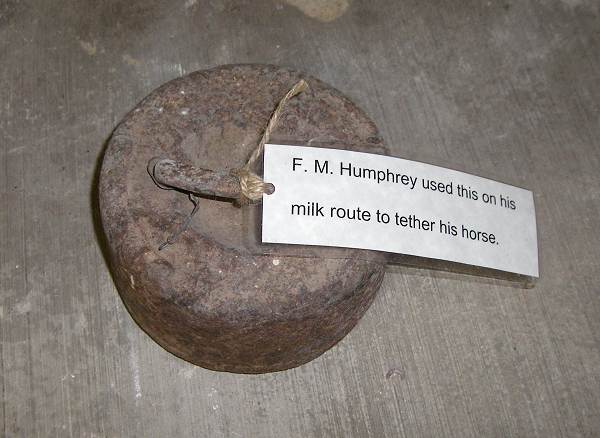
34 Weight to tether Horse
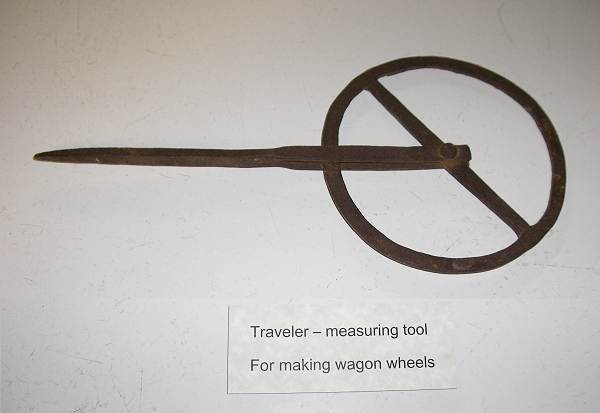
35 Traveler Measuring Tool
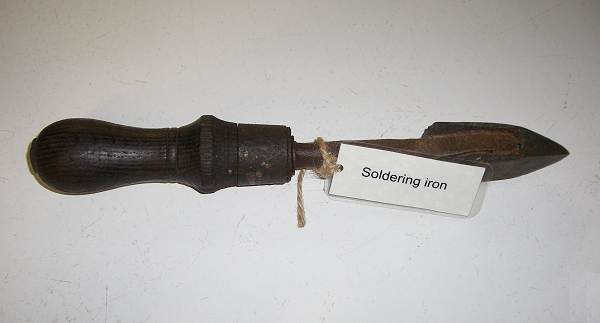
36 Soldering Iron
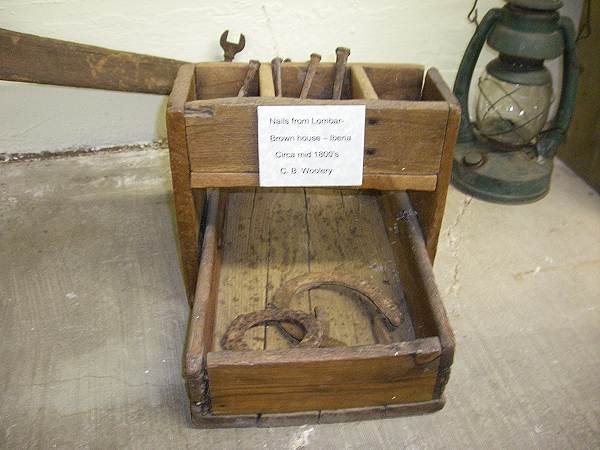
37 Nails and Shoes from Lombard Brown house in Iberia
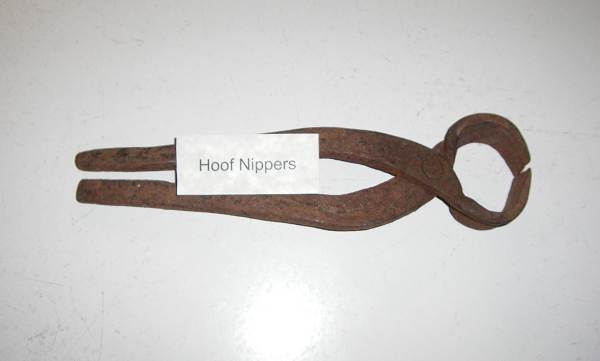
38 Hoof Nippers
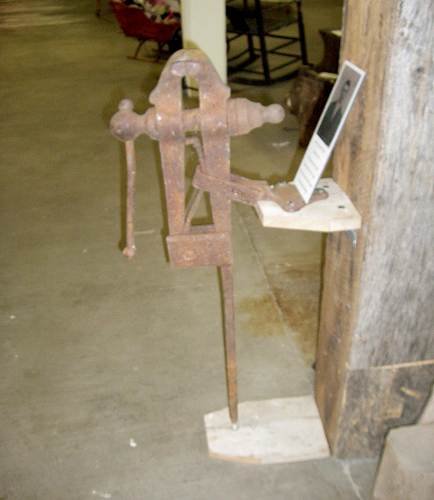
39 Blacksmith Vice of Henry David Wall
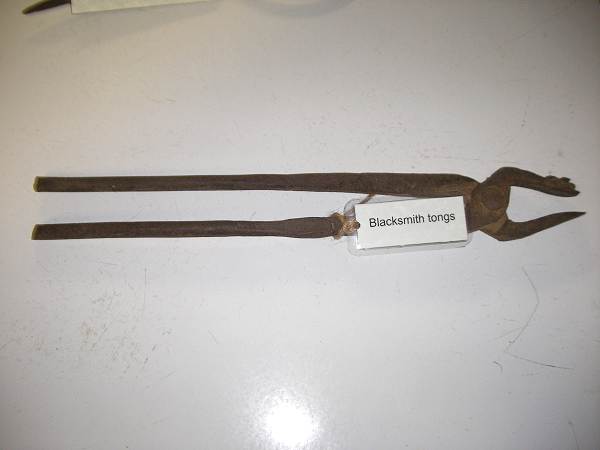
40 Blacksmith Tongs
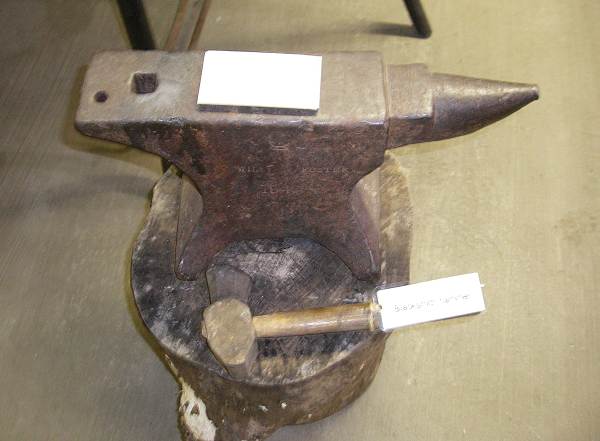
41 Anvil of James Wright - Late 1800's
For those who want an in depth discussion of Miller County blacksmiths I have researched our website for narratives about Miller County blacksmiths and put the information together as an attachment. The information contained in this attachment is quite extensive so I decided not to make it a part of the main body of this week’s Progress Notes. A great amount of information about Miller County blacksmiths can be found in this extensive summary. For more information about any one of those listed you can click on the URL above the narrative to go directly to the website where the complete discussion is located (photo 42).
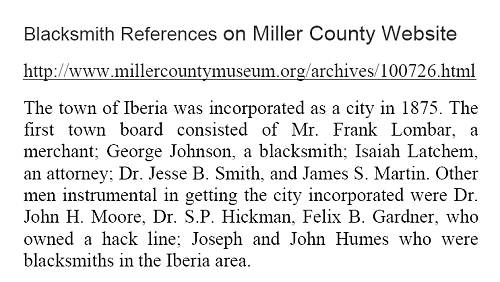
42 Blacksmith References on Website
Click image to read entire document in PDF format
For more detailed information about forging, bending and welding as well as history of the blacksmith, check out this entry at Wikipedia.
More information about what a farrier does can also be found at Wikipedia.
And for a very interesting tour of a blacksmith and farrier museum, go to this website.
In the early fifties the Eldon Advertiser published a story about the first one hundred car train to leave Eldon, an event which occurred in 1928. Eldon was reaching the peak then of its glorious and romantic early history, mostly due to the trains coming to town back in the early 1900’s. Before reading the story which I will present below, you might want to read two previous editions of Progress Notes which tell the story of the trains which passed through Eldon. The first edition is a general historical summary of the Eldon train story which can be reviewed at this previous Progress Notes.
The second Progress Notes edition which is of interest regarding Eldon train history is the story of the Gary Carrender family (Gary is one of our MCHS board members) which relates the history of his grandfather, Charles Jasper Carrender and of his father, Roy “Casey” Carrender, both of whom spent their lives working for the Rock Island Railroad (photos 43, 44 and 45).
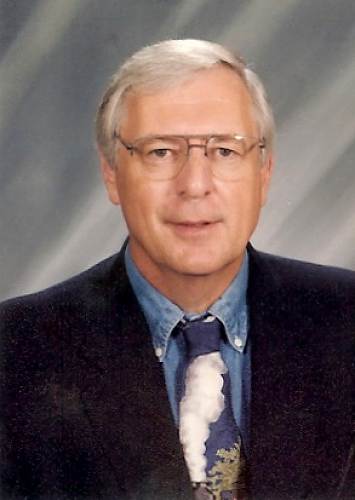
43 Gary Carrender
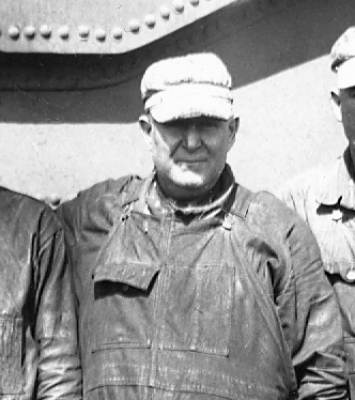
44 Charles Jasper Carrender - Fireman
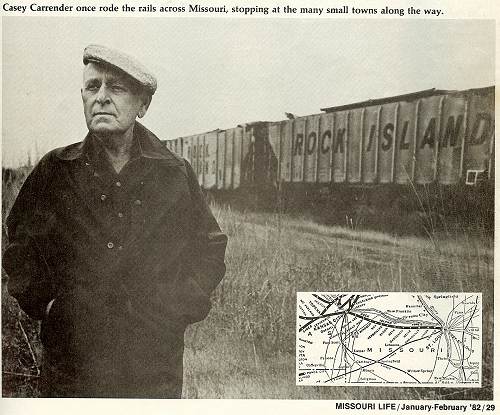
45 Roy Casey Carrender
Click image for larger view
After that introduction here is the story of the First One Hundred Car Train to leave Eldon:
First 100 Car Train Out Of Here In 1928
Eldon Advertiser
Cerca 1958
Today long freight trains are a common occurrence. But like everything else, there was a first. It was on July 9, 1928 that the Rock Island started a train of 100 cars out of Eldon for Kansas City. This was the longest train ever operated out of Eldon.
The crew in charge of that first 100 car train from here included E.J. Boyer, conductor; A. G. Darrall, engineer; H. Francis, fireman; and C. Apperson and I. Apperson, brakemen.
The train consisted of 100 empty cars going to Kansas to be loaded with the new wheat crop.
Little less than a year, after that record, another was set. In June, 1929, more than 123 million gross on miles were handled over the St. Louis-Kansas City terminal division, according to the old Advertiser files. This was the largest single month ever up to that date on this division.
In one day during that month, a Thursday, more than 5 million tons were handled, the heaviest single day on record on the division. Twenty four trains ran that one day.
Another first was set in the post World War II years here, but records are not available on the exact date. That was the day when the first diesel engine was put into use on the St. Louis-Kansas City line.
Railroaders recall that it was on an eastbound through freight, but guesses on the year have ranged from 1946 to1949. Check of the Advertiser files for those years failed to locate the story. However, C.A. Moss, train conductor, pinpointed the date as being in November of 1949. He was conductor on that first diesel powered train east out of Eldon. Check of his time slips disclosed he made a run west from Eldon on Diesel 41 on November 27, 1949, and that initial run east was shortly before that. Ed Hunt, who then had the Ford agency here, took movies at Eldon and Etterville of the first diesel unit. Many railroaders have seen the pictures.
Some recall that Lon Decker, engineer, brought the diesel in here from Kansas City, and that Earl Koontz, road foreman; R.E. Johnson, superintendent, and W. L. Hunt, trainmaster, rode it out of here.
Ross Etter was engineer on the run into St. Louis and Chester Vernon, fireman. But that’s about as far as we’ve been able to trace the story of that initial diesel run.
On March 29, 1923, there was a story regarding the possibility of Rock Island trains Nos. 39 and 40 being restored, giving Eldon eight passenger trains a day…six on the Rock Island and two on the Missouri Pacific.
On June 21, 1928, a story related that flood waters had put railroad transportation out between St. Louis and Kansas City except over the Burlington. The south part of Miller County received part of that rainstorm of 30 years ago. The Osage River showed an 8 foot rise one day with a 3 foot rise during the night so the ferry at Bagnell was stopped.
Residents who attended the Fourth of July picnic at Eldon in 1929 may recall witnessing the fire that destroyed the Rock Island Station in Eldon. About 9:30 p.m. as the crowd enjoyed the American Legions’ celebration at the park, fire was discovered in the elevator alongside the tracks, operated in partnership by L.D. Evans and Charles Granstaff.
Flames were bursting from the elevator when firemen arrived, but they saved nearby buildings. Loss was estimated at $15,000. The elevator held more that 4500 bushels of the previous year’s wheat.
Others my recall the fire that destroyed the Rock Island coal chute about 5:30 a.m. Saturday, July 25, 1931. Smoke was seen coming from the coal bunkers and when the doors were opened, flames spread the length of the building.
Engineer J.R. Phillips sounded the first distress signal from his engine. He kept it up loud and long until the roundhouse alarm and city fire alarm took it up awakening the entire city. City and Rock Island department fire units protected nearby property.
Readers may recall that Ralph Budd, who later became president of the Chicago, Burlington and Quincy Railroad, once was employed here. Also, Herbert Irwin, shown in the accompanying picture of the force at Eldon, now is vice president and treasurer of the Delaware and Hudson in New York City.
Here is an old photo taken at the Rock Island Station which accompanied the article above. It includes a long caption naming all the Eldon individuals working there at the time. The caption does not give the exact date of the photo but gives some clues that perhaps a former Rock Island employee might recognize to help us date it (photo 46).
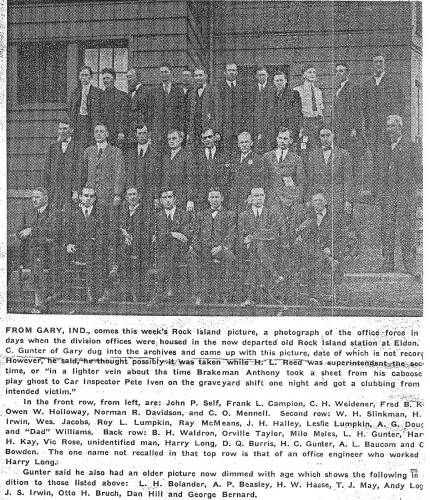
46 First One Hundred car train out of Eldon
Click image for larger view
One of the most interesting and fun to read books about Eldon was written quite a few years ago by Eldon native, Bob Richardson, titled “Up The Caboose” (photo 47).
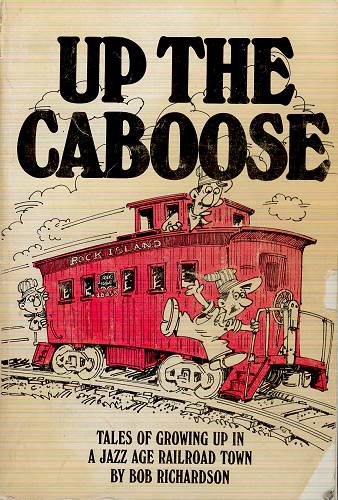
47 "Up the Caboose" Book Cover The book is out of print now but many Eldon natives have a copy (You might find used ones occasionally for sale on Amazon.com). The book, in addition to being enjoyable to read, gives a good account of some of the history of Eldon trains in the early part of the last century.
From our files I have some photos having to do with the Eldon railroad story. The first three photos are of the homes of three very early Eldon railroad employees. On the porch of these homes are the individuals who were railroad employees, although it is difficult to make out their features (photos 48, 49 and 50).
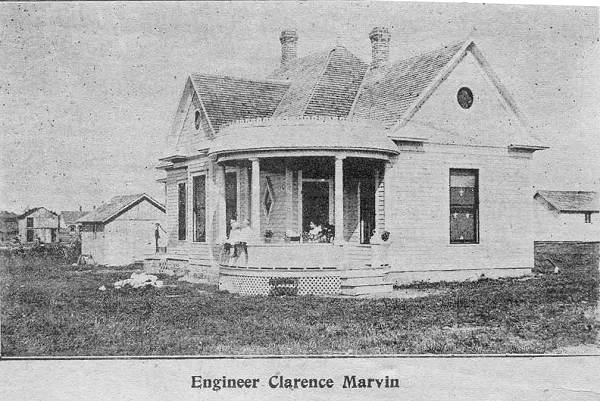
48 Clarence Marvin - Engineer
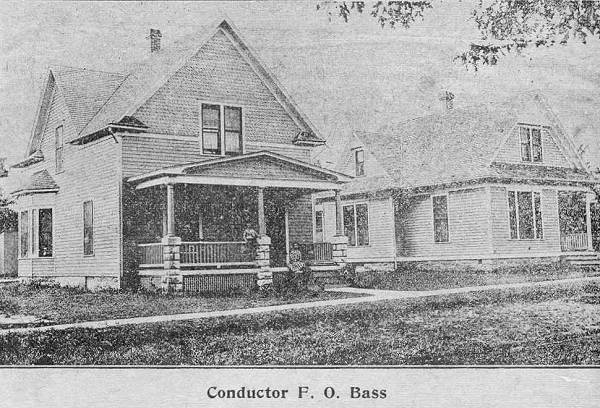
49 F.O. Bass - Conductor
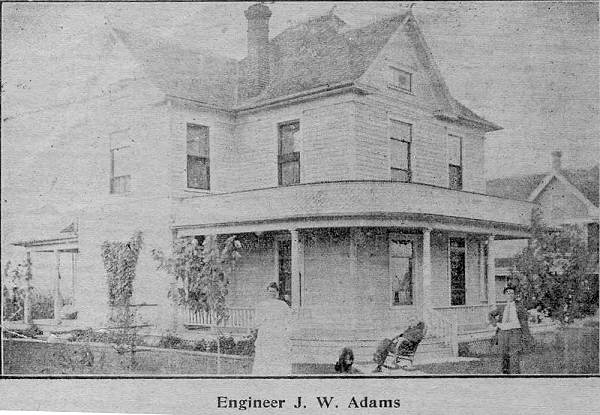
50 J.W. Adams - Engineer Here are three photos of Rock Island employees from the 1920’s and thirties who worked about the same time as the Carrender family (photos 51, 52 and 53).
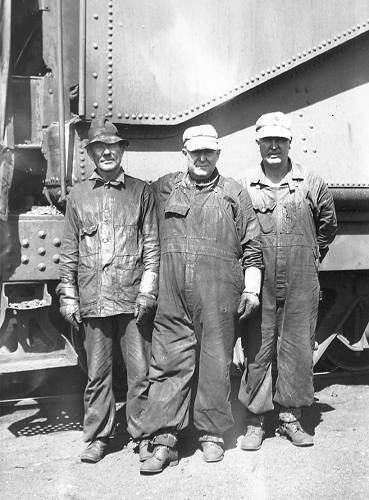
51 Bert Hays, Charles Jasper Carrender and Ab Strange
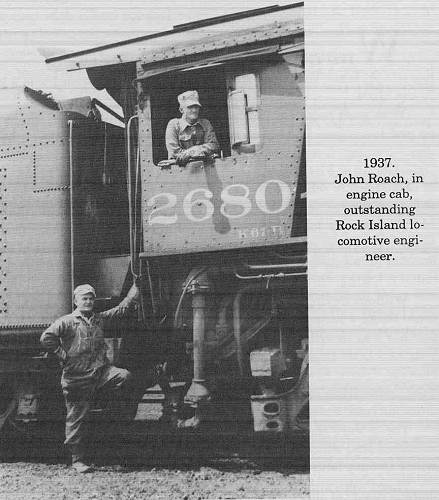
52 John Roach - Rock Island Engineer
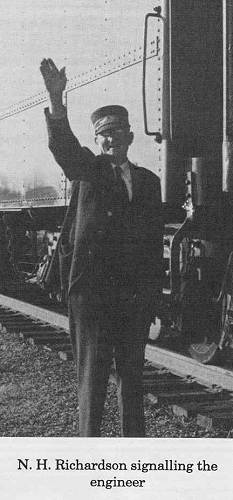
53 N.H. Richardson - Rock Island Conductor Next is a photo of a Rock Island caboose and Rock Island work crew (photo 57).
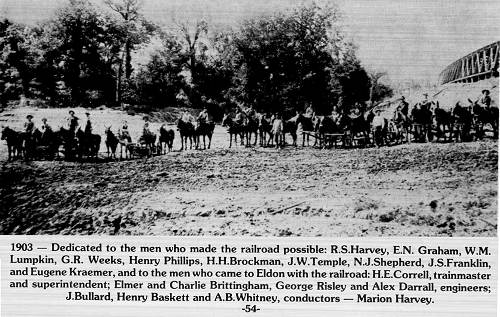
57 Rock Island Work Crew
Click image for larger view
The Missouri Pacific and Rock Island train stations are featured in these next four photos (photos 58 - 61).
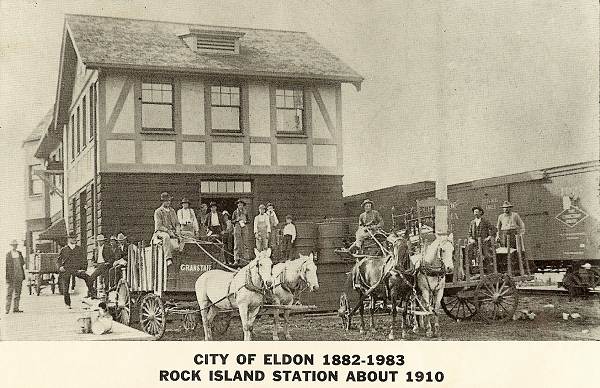
58 Rock Island Train Station
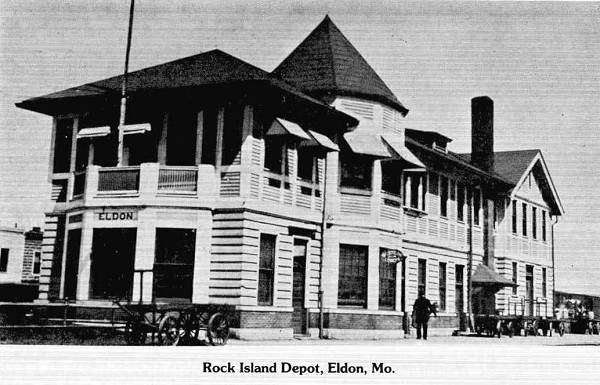
59 Rock Island Depot - Eldon, MO
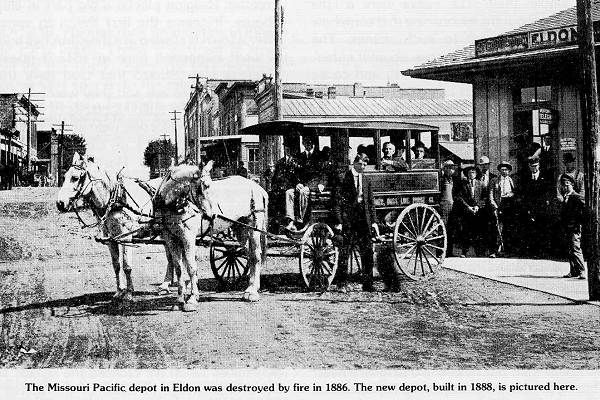
60 Missouri Pacific Depot in Eldon, MO - 1888
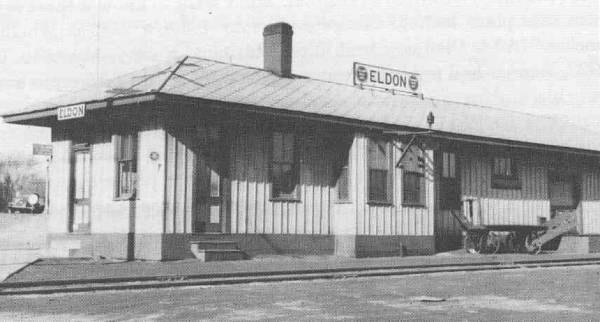
61 Missouri Pacific Branch Line Depot in Eldon, MO Gary Carrender (photo 62a) has a very interesting painting of the Rock Island train featuring a background scene located on one of the western deserts (photo 62b).
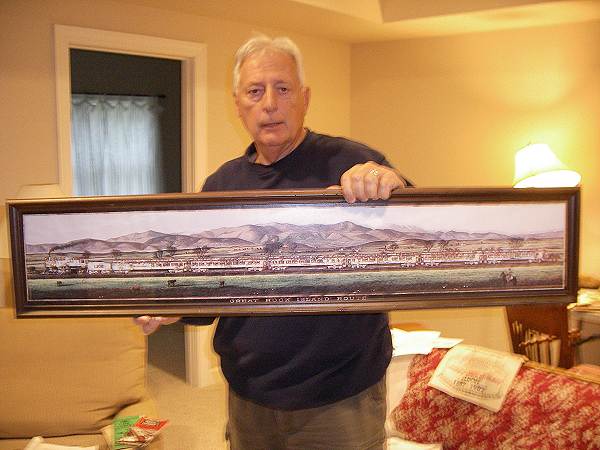
62a Gary Carrender with Rock Island Train

62b Great Rock Island Route
Click image for larger view
He told me the following about the painting:
Joe,
The painting is titled "The Great Rock Island Route" with #1302 on the coal car. There are six passenger cars with one labeled "dining car." There is no information on the back and it has been sealed nicely in the frame. I can see where something was taped to the back, which probably provided the information describing the painting. What I have is a print. If I come across the information that was once on the back I will let you know. I do remember seeing something on the back when it was at my parents’ house. Gary
|
Perhaps one of our readers of this website might have more information about this painting, which is quite large and long.
I want to thank our website designer, David Statler, for so artfully and skillfully joining the two halves of the long print Gary is holding, for which I had to take two photographs to get the close-up.
As time passes by fewer of the original employees of the Rock Island Train are left with us to tell the wonderfully interesting stories of the “heydays” of the railroad era. My memories of the Rock Island station from earlier in my life are quite vivid. Once weekly my father and I would take a truck load of large cardboard boxes filled with cedar wood souvenirs to the station which were sent by train to locations all across America. These souvenirs, made from native Missouri aromatic red cedar, were crafted by Miller County people at our family’s shop in Tuscumbia (our family included my two uncles, Fred and Ansel, and their children as well; all of us one time or another worked at the two shop buildings in Tuscumbia).
Last month in his column in the Eldon Advertiser Wallace Vernon (photo 63) wrote about his memories of William M. Harrison (photo 64), the early Miller County court official and banker who was very important in the history of our county during the late 1800’s and a good portion of the first half of the 1900’s.
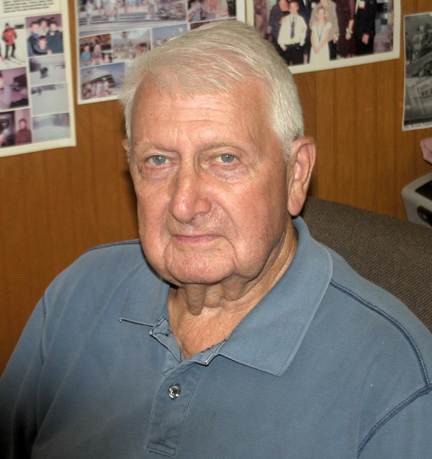
63 Wallace Vernon
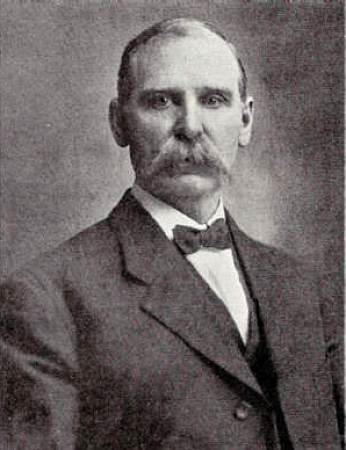
64 William M. Harrison Wallace is one of the few remaining Miller Countians who would remember well Mr. Harrison. Here is Wallace’s short article:
The Eldon Advertiser – Thursday, Feb. 3, 2011
Wallace Vernon
NOW COMES A NOTE from one Peggy Harrison of Centennial, Colorado, whose appreciation of Eldon’s early residential architecture coincides with that of the Ex Publisher. Peggy, who grew up in the Harrison house up on Newton was interested in knowing more about her great grandfather, Uncle Billy, who EP mentioned in connection with that historical landmark.
Well, let me tell you, Ex Pub’s recollection of Uncle Billy stems from very young childhood, but the recollect is pretty vivid because about the only place I remember seeing him was up behind the pulpit of First Christian Church where he presided every Sunday morning as Superintendent of the Sunday School.
(Yes, this meant that we confronted each other every Sunday...EP was one of those whose mother made sure he was in Sunday School every week, at home or abroad. If away from home we attended someplace and made sure we had written proof to bring to the teacher back home. We have the gold medal with at least ten yearly bars to attest!)
But I digress, Uncle Billy appeared to be a sizeable man to me with an impressive handlebar mustache and he conducted business from the podium with considerable authority.
As I go around the county collecting historical information and biographies I have learned that the memory of those who are old enough to have been around when our forefathers were alive is invaluable. Even just a “snippet” of memory here and there is worth something when it all is added together.
I had written about the Harrison family and its connection with the Citizen’s Bank of Eldon in a previous Progress Notes.
I was very grateful to Jean Harrison, husband of Don Harrison Jr., who was president of the bank until his death in 2004, who gave me much of the information for the historical review of the bank and the Harrison family. Here is a summary of the career and life of William M. Harrison:
In 1885 Mr. Harrison was elected school commissioner of Miller County and occupied that position for two years. In 1887 he was appointed deputy sheriff and collector under W.C. Howell, and in 1888 he was elected county treasurer of Miller County, to which position he was reelected in 1890, serving in all for four years. He retired from that office as he had entered it…with the confidence and good will of all concerned…and following his service as county treasurer he was appointed deputy sheriff under J.M. Wickam. He afterward became deputy collector under Boyd S. Miller, and in April, 1895, he was offered and accepted the position of cashier of the Bank of Eldon. He acted in that capacity until December, 1898, when he resigned his position to assume the duties of clerk of the circuit court and recorder of deeds, to which office he had been elected in the previous November. In 1902 he was reelected and served continuously for eight years. Following the expiration of his second term he once more entered the Bank of Eldon in the capacity of assistant cashier and on the 21st of October, 1907, he was made cashier of the Citizens Bank of Eldon, which position he filled until his election to the forty fifth general assembly in 1908.
Here is a photo of the Harrison family home in Eldon, now occupied by Don Harrison III and his family (photo 65):
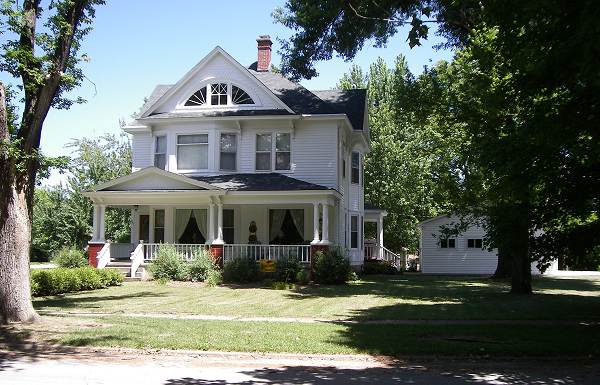
65 William M. Harrison Home in Eldon, MO Another old photo taken in 1901 at the south end of the courthouse includes William M. Harrison when he held the position of Circuit Clerk and Recorder of Deeds at the County Courthouse in Tuscumbia (photo 66).
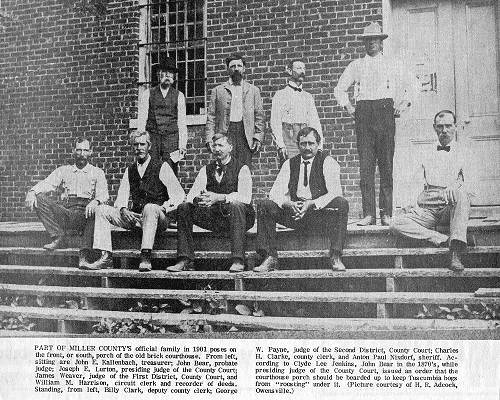
66 County Officials - 1901 - Wm. Harrison sitting Fifth from Left
Click image for larger view
The courthouse was old at the time the above photo was taken having been built in 1859. Here is a complete photo of the old courthouse (photo 67).
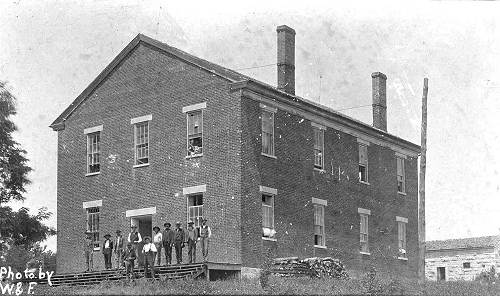
67 Old Court House - Bult 1859
Click image for larger view
In 1910 a stone courthouse was built around the brick one (photo 68).
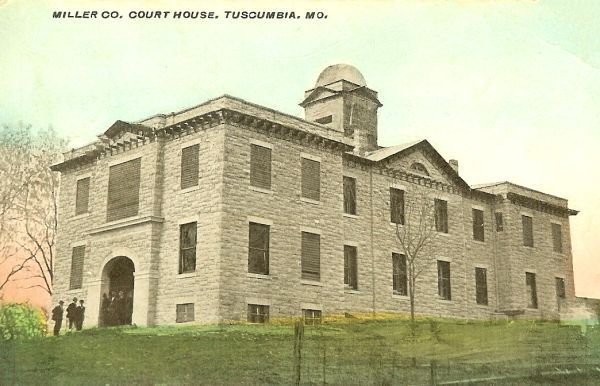
68 Miller County Courthouse - 1910 The current courthouse was built at a site on Highway 52 north of the original courthouse square in 1984 (photo 69).
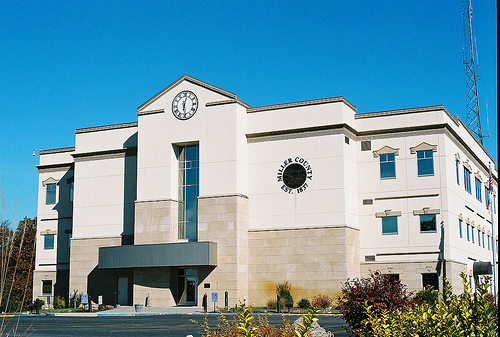
69 New Court House When William Harrison was a county officer he lived in Tuscumbia, even though his family home was located on a farm near Eldon. In those days because of the difficulty of travel, many times those elected to county office would move to Tuscumbia. William lived in a home on top of the hill across the road from the Tuscumbia School. The home not only housed William during its lifetime but also Helen Fendorf Phillips who lived there as a child, and later T.C. Wright, the well known educator. Here is a photo copied from the Autogram (I don’t have the date) which pictures the home when William Harrison lived there and a second photo at the time the home was being removed in the early 1960’s for the construction of the new Tuscumbia bank and post office (photo 70).
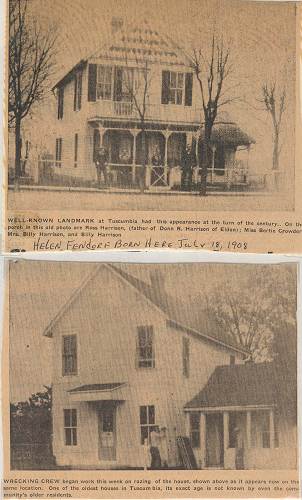
70 Harrison Fendorf T.C. Wright House
Click image for larger view
That’s all for this week.
 Joe Pryor
Previous article links are in a dropdown menu at the top of all of the pages.
|

